
views
Checking the Vehicle and Clearing a Path

Look for signs of a dead battery. Confirm that the battery is indeed dead by turning the key in the ignition and seeing how the car reacts. Common signs of a dead battery include a clicking noise from the starter, the engine turning over slowly, and the dashboard lights not coming on. If the dashboard lights come on but the starter clicks or turns over slowly, that’s because there is power left in the battery, but not enough to start the engine. If nothing happens at all when you turn the key, the battery is completely dead. If all the lights come on and the engine keeps trying to turn over without starting, the issue is not the battery. It’s more likely an issue with fuel delivery (fuel pump, fuel filter), an issue with airflow (intake, mass air flow sensor), or a problem with the vehicle’s ignition system.

Determine if you’re on too steep of a hill to push start the car safely. It’s not safe to push start a car on a steep slope because you may lose control of the vehicle if it fails to start. A slight incline may help get the car rolling, but anything steeper than that is too dangerous for you to attempt push starting a car. The car won’t have power steering or power brakes until the engine starts and is running, so never attempt to push start a car down a steep hill.
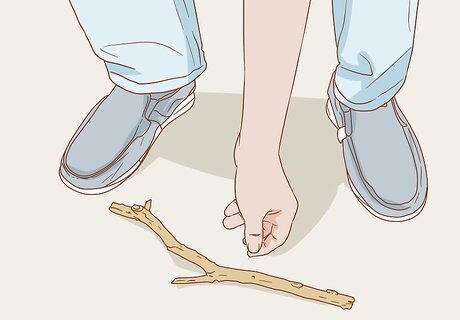
Clear the path of the car. Because steering and braking will be difficult while push starting the car, move anything it could hit out of its path. Look for obstacles you may not be able to move as well. If there are trees or other immovable objects in the way, it is not safe to push start the vehicle. Make sure there’s nothing in front of the vehicle for at least 300 feet (91 m) so it can roll in a straight line. Push the car slowly to re-orient it if the path in front of it is not clear.

Insert the key in the ignition and turn it to the on position. Turning the key to the on position will feel just like starting the car, but because the battery is dead, the engine won’t start. This unlocks the steering wheel and will allow you to steer. The key must be in the “on” position when you push start it. Otherwise, the engine won’t start when you drop the clutch. The key will unlock the steering wheel, but remember that you will have no power steering until the engine is running.
Engaging the Engine
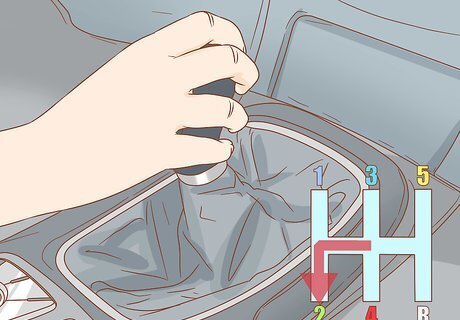
Put the transmission into second gear. Second gear is the easiest gear to push start in, though you could potentially use first or third if there’s a problem with second gear in your car. Press the clutch with your left foot and then slide the gear selector all the way to the left and back to place it in second gear. First gear has a lot of torque, so the vehicle could buck unexpectedly if you use it instead of second gear. You need to achieve a higher speed to push start the vehicle in third gear than you do in second.
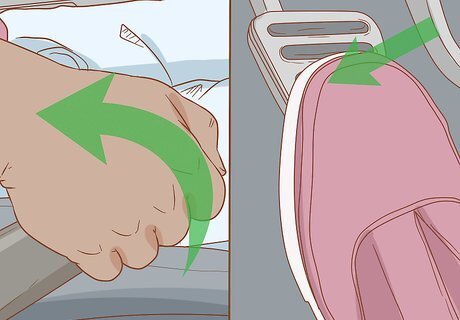
Release the parking brake and press the brake and clutch pedals down. Depending on your car, the parking brake will either be a peddle located near your left knee while in the driver’s seat or a handle in the center console. Press the clutch with your left foot and the brake with your right after you release the parking brake. If you are unsure of where to find the parking brake, refer to the vehicle’s owner’s manual or the manufacturer’s website. If you are on a slope, be sure to hold the brake pedal down as you release the parking brake to prevent rolling.
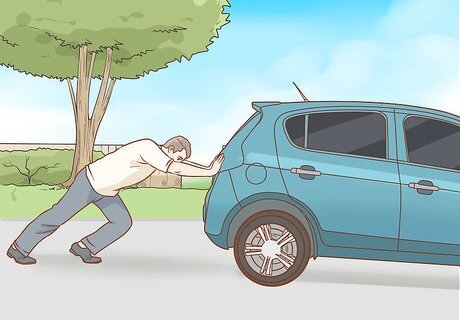
Release the brake as your friends start to push the car. Make sure your friends push on the back of the vehicle in a safe spot like the bumper or the trunk lid rather than the spoiler or back window. Take your right foot off of the brake pedal as they begin to push the car. Tail lights, spoilers, fins, and windows are not safe places to push on. One person can push most cars fast enough to get them started, but a few friends will make it easier.
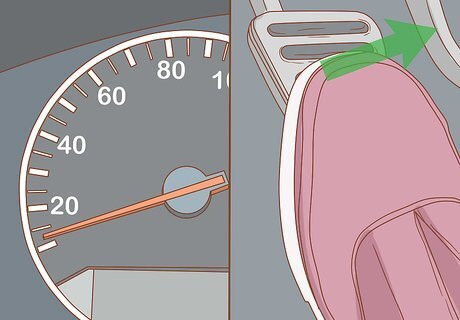
Drop the clutch when the speedometer reaches 5 mph (8 km/h). As your friends push, focus on keeping the car moving straight and on the speedometer. Once the car is rolling at 5 mph (8 km/h) or faster, pull your left foot off of the clutch abruptly (commonly called “dropping” it). That will connect the engine’s crankshaft to the spinning wheels through the transmission and force the engine to begin turning. The faster you’re moving, the more likely the engine is to start when you drop the clutch. The engine will buck and sputter as it starts. You don’t need to give the engine any gas, but may choose to. Remember that doing so will make the engine and car both accelerate.
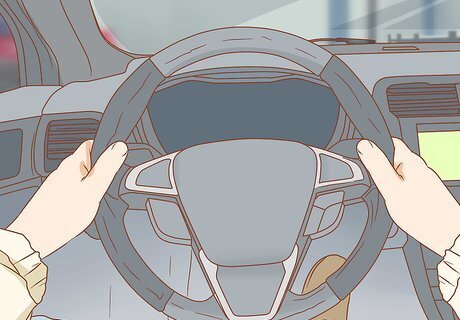
Keep a tight grip on the steering wheel, especially in front wheel drive cars. Front wheel drive cars are prone to torque steer, which is when the engine’s torque turning the wheels also turns the steering wheel to one side. Keep a tight grip on the wheel to prevent the car from changing direction. Torque steer happens only briefly as the engine tries to turn the wheels faster than they’re already turning. Torque steer will just feel like a short jerk in the wheel as the engine starts.
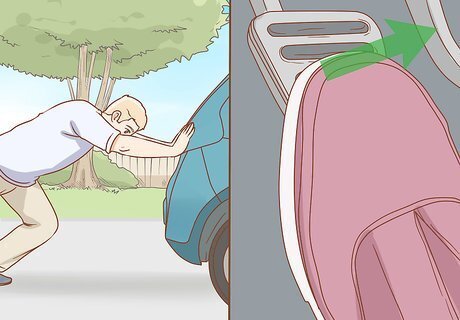
Try again if the engine didn’t start. If the engine failed to start but the car is still rolling, press the clutch pedal all the way to the floor and then drop it again. Have your friends keep pushing to help bring up the speed as you do. If the engine fails to start, it’s likely because you weren’t rolling fast enough. Repeat these steps until the engine starts up when you drop the clutch.
Stopping and Charging the Battery
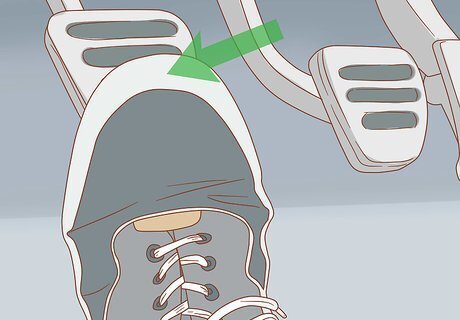
Press the clutch back down after the engine starts. Once the engine starts, the alternator produces the electrical charge it needs to keep running. Press the clutch back to the floor with your left foot so you stop accelerating. With your foot on the clutch, the engine’s RPMs (Revolutions Per Minute) will drop down to an idle. The alternator will recharge the battery and keep the engine running.
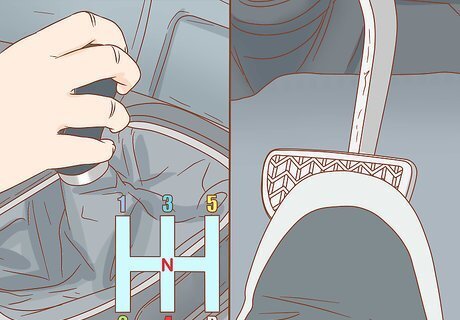
Put the car in neutral and step on the brakes. Keep your foot pressed firmly on the clutch as you push the gear selector forward into the neutral position. This takes the car out of gear. Then use your right foot to apply the brakes and bring the car to a stop. You can take your left foot off of the clutch once the car is in neutral. Do not shut off the car once you stop.

Let the car run for at least 15 minutes to charge. It will take the alternator a while to recharge the battery sufficiently, so leave the engine running once you stop. If the lights were on but the starter was just sluggish, 15 minutes will probably do. However, if the battery was too dead even to turn the lights on, 30 minutes to an hour might be more appropriate. You can drive the vehicle around while it recharges the battery. If you shut the engine off before the battery is charged enough to start it again, you’ll have to start over.












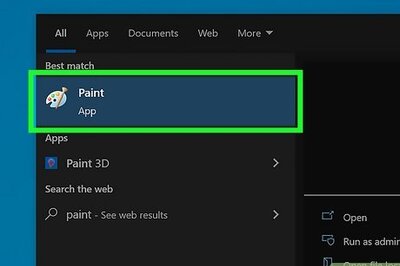






Comments
0 comment